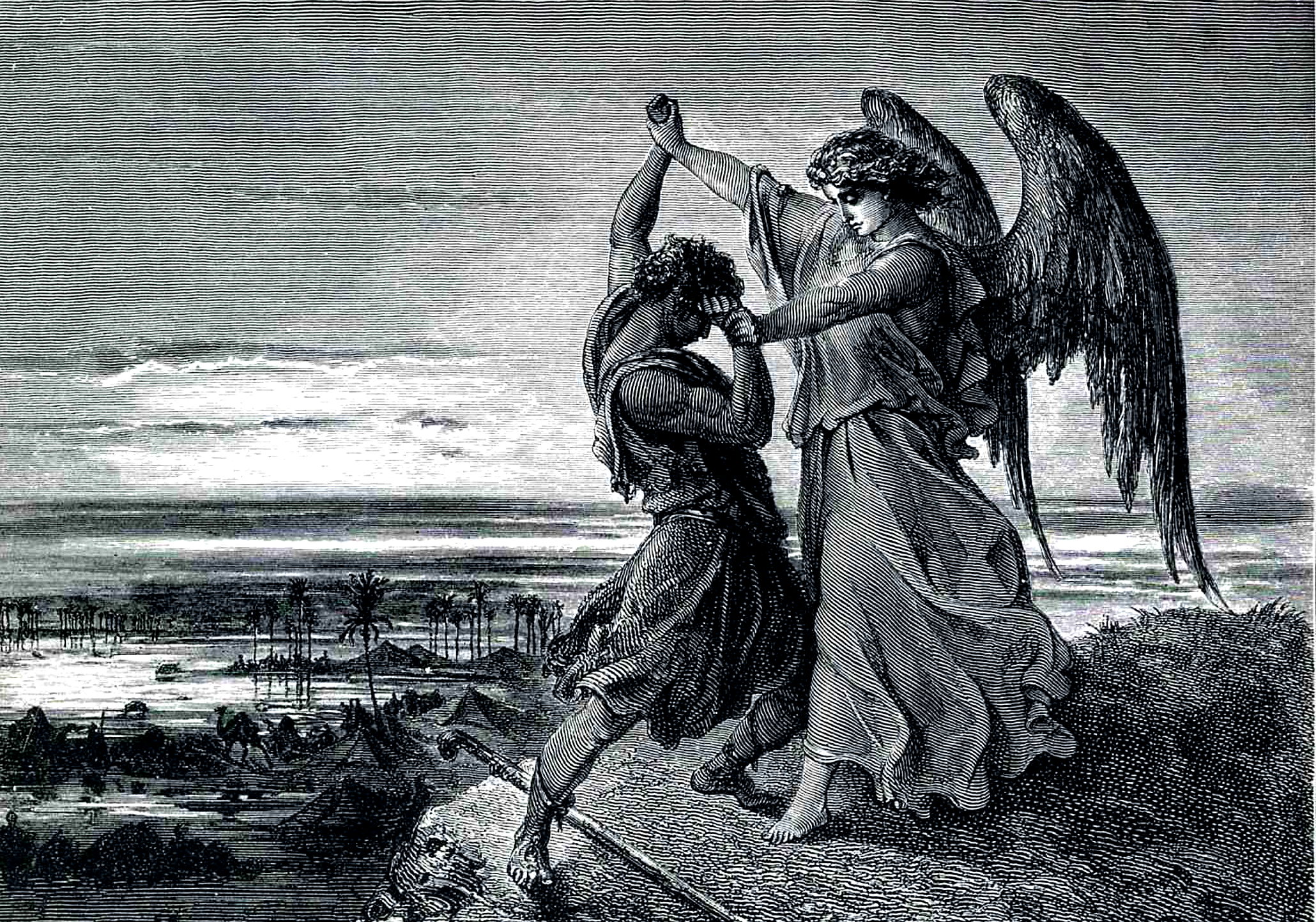Consider the thieves’ guild.
The thieves’ guild is an odd artifact of fantasy games. Once you accept that a hero can be a thief, you begin finding ways for the thief to belong to the world. Wizards have colleges and councils. Fighters become knights, become lords, and even become kings, ruling by this ax. Clerics have their religious hierarchies. The choirs of angels have nothing on the politics of churches. Thieves, though, are inherently outsiders. They prey upon the world. Yes, Hobbits get led astray by dirty road dwarves into being burglars, but that is not quite the same thing. A thief is more than just someone who sneaks around. Thieves’ have their own subculture. In fantasy games, it is called a guild.
Literary Origins
The earliest example of the thieves’ guild I could find was by Cervantes. Rinconete and Cortadillo (Or, Peter of the Corner and the Little Cutter) was about a Spanish group of thieves who structured themselves as medieval trade guilds. Unless I missed something, this is the first fictional thieves’ guild.
After that, there are a few examples who are not formally called a thieves’ guild. Moriarty’s crime ring is an example, and, by the way, is based on a real group. The Baker Street Irregular could also be considered relatives of the thieves’ guild. In Oliver Twist, the team of pickpockets run by Fagan and Artful Dodger are certainly an example. The Pirates in tales like Treasure Island are a criminal fraternity not unlike a thieves’ guild, as well
The 20th century saw the explosion of Fantasy literature. Pulp fantasy in the 1930’s brought us Conan and his ilk. The classic reference to thieves’ guilds, and probably the reason they are in D&D, is with Fafhrd and the Gray Mouser. The city of Lankhmar is a classic setting for urban adventure with Thieves guild being major early threat. The story “Thieves’ House” gives some detail and history to that guild, and it is surprisingly supernatural. So much of how thieves’ guilds are presented in D&D is drawn from the Lankhmar stories. They are mostly used as foils to Fafhrd and Mouser, but the tone and purpose of the guild is well established here.
After that, thieves’ guilds have become well represented in fantasy literature. Discworld has the guilds of Ahnk Morpork. The Guild of Thieves, Cutpurses, Housebreakers and Allied Trades is but one of the guilds which take people’s money, but probably the most honest one about that job. Brust’s Jhereg is about a member of a criminal guild who is having difficulty fulfilling his contract to do a job. The Gentleman Bastards series is largely about thieves delightfully doing wrong. The Lies of Lock Lamora is an excellent example of how guilds in a city might operate, compete with one another for control, and recruit new members. Those are a few examples, but there is quite a range of material to draw on.
Movies also have some great examples. Oceans 11, 12, and 13 are all really about a band of thieves (a guild if you will), pulling off impressive robberies. They even have their own language, of sorts.
“Off the top of my head, I’d say you’re looking at a Boesky, a Jim Brown, a Miss Daisy, two Jethros and a Leon Spinks, not to mention the biggest Ella Fitzgerald, ever. “
The Sting is a predecessor to the recent Oceans films and, again, it is all about long con jobs and big thefts by thieves’ guilds. They have special gestures, nods and signals to let each other know they are in on the con. This could be an example of a thieves cant, actually. It is also an excellent film and you should go watch it.
John Wick, and the more recent John Wick Chapter 2 both show a deeply organized criminal underworld. They have their own traditions, currency, and rules which need to be followed. They have a service economy incorporated there. Yes, it is more assassins than thieves, but if you watch those movies and don’t get ideas for thieves’ guilds, you are not trying very hard.
The Real World
Note: Some details from real–world organized might help you design your own guilds. Grounding is good. That said, bear in mind that the real-world version of organized crime is not charming, or fun. There might be some colorful characters, but the various forms of the mob are terrible. They make life hard for everyone. They are often venal, psychopathic, and indefensible. Bear in mind these are the people who run most of the sex traffic and drug trade in the world. They will hook 13-year old’s on drugs then sell their bodies to pay for those drugs. Your PC’s want to be heroes. They don’t want to be part of the real mob.
The Real world has its own version of guilds. They are less romantic and delightful. Organized crime has existed for a long time, but they were often called Pirates, or collections of bandits. Robin hood and his merry men are a classic rural thieves’ guild. It was more of a rural phenomenon when the places between cities were not safe to travel. The roads were long and dark, and police were rare if not nonexistent.
The seas had infamous pirates for as long as there has been trade ships on the ocean. If the roads are long and dark, the seas are even more so. There are records of pirate raids along coastal routes going back to the misty depths of antiquity. The “Sea People” are an odd historical group of unknown origin that raided everybody in the Mediterranean more than 3000 years ago. They often are credited as the first recorded pirates.
In the 17th, 18th and 19th centuries, organized crime started to become a city problem. Larger populations with large underclass lead to fraternities of crime. That is the standard line, and it is easy to verify. There is a strong likelihood that organized crime existed in cities before that, but there is very little evidence of it. The real-world groups we do know about are pretty fascinating.
As I mentioned before, the character of Moriarty was based on a real criminal named Adam Worth. He ran an international criminal organization and was called “the Napoleon of Crime” well before his fictional counterpart.
The Yakuza is a good example of the classic ethnic criminal gang. They date back to the 17th century and started by two of the lowest castes in Japanese society at the time. The rituals from that time are still practiced in the Yakuza today. Modern day Yakuza is a accepted part of Japanese society. They are so public as to have fan magazines, websites and the like.
LA Costa Nostra has existed since the early 19th century, and probably started during the transition Sicily went through at the time from feudal to a more individual-oriented land ownership. This group is the one people think of when they think organized crime. When they immigrated to the US as part of the immigration boom, they brought the Sicilian Mafia with them. Disenfranchised early on, they used those ties and criminal methods to seize power for their own communities.
Real world criminal groups organize in different ways. Some form using hybrids of different factors.
- Ethnic: Many gangs through the years have organized along ethnic lines. Russian mobs, Yakuza, Tongs and few others are examples of this. It is often justified as “defending” the ethnic group they are from. Irish mob’s would sell themselves as defenders of the Irish immigrants in an America that was not particularly nice to them early on. There are groups that formed in African American, Hispanic, and other communities for similar reasons. The Aryan Nation is another ethnic gang, with a white supremacist angle.
- Family: Specific family lines often run whole sections of organized crime. This is often stereotypically pointed to with Italian mafia. The Five Families were Bonanno, Colombo, Gambino, Genovese, and Lucchese and they split up control of New York. Even after Lucky Luciano rose to power and the head of the Commission, the Five Families held a large amount of sway with the mafia across the country. There are other examples of crime groups run by a single family. It has the advantage of having built-in extra loyalty, though betrayals still happen.
- Local: The average street gang survive bests with a local focus. They know the neighborhood, the players involved, and the customers all personally. The 18th street Gange of Los Angeles is a good example of this, as it Bowery Boys of New York. Robin Hood, if he existed, would be a local gang leader in Sherwood. A local gang can still have a long reach.
- Religious: Hashshashin, or as you might have heard of them Assassins, were devoted followers of a brand of Islam involving a supposedly magical Old Man of the Mountain and extensive use of Hashish. They are the origin of the term Assassin, and arguably the first assassins’ guild. There I a religious element to La Cosa Nostra and others. The Templars of northern Mexico justify their brutality as being religiously sanctioned. Religion is a defining element for many real-world criminal groups.
- Trade or Business: There is an honesty to treating crime like a business. The Commission was the American Mafia’s way of trying that. Russian Oligarchs often operate in the veneer of business. The Teamsters were often considered so close to the mafia to be considered part of the organization. Some of the earliest notes I could find on real world organized crime was the mention of “immoral guilds” in Turkey, where there were trade guilds but for things like pickpocketing. The evidence for that is scant, but there are some old references to it.
Criminal groups rarely just follow one of those organizational styles and elements. It is usually a mix. The Mafia has followed several over the years. In many countries throughout history, it has been hard to tell the difference between the criminals and the government, as well. Things are made more complicated by the required secrecy of such groups. How they make money is easier to describe.
The Crimes
I am going to list some crimes organized criminal groups actually participate in. There are no mass murders and worse crimes. The mobs of the world are terrible, but there is no profit in some crimes, and are not things they do as organizations. Also, this is largely to inform game worlds. If you want child molestation in your fantasy game world, stop reading this, don’t follow the blog, and maybe seek professional help.
Most organized crime traditionally made their money of protection schemes, or racketeering. The would offer to protect someone from harm. It might be protection from oppressors, but the harm was also offered by the same group offering the protection.
“Nice shop you got there. It would be a shame if something were to happen to it.”
Protection rackets work in fantasy worlds just fine. Yes, it is terrible, but so is beating up people and stealing their stuff. The Guild in a city may make income that way, and only send thieves to steal from those who fail to pay up, or to steal from those who hurt folks under the guild’s protection. It depends on how altruistic you want to be.
Kidnapping professionals have been a part of organized crime since the beginning, and it still is. Columbia and Mexico have both competed for the title of “Kidnapping Capital of the World.” It is an odd crime to make work. You usually need a crew, a safe place to keep the victim, information on the targets, and a way to process the ransom when received. The more professional groups will release the captive afterwards. The less pleasant ones will not.
Kidnapping works for fantasy game guilds, if you are using them as bad guys. A great adventure might be the heroes were recruited to rescue the victim from a guild. That can be exciting and have a complication of time and protecting the person you were sent to rescue.
Organized crime also made a lot of money from moving and selling illegal things, so smuggling. During prohibition, that was booze. These days, it it is various forms of illegal drugs. It also has been a smuggling people. The modern face of slavery is often the member of the mob. Smuggling people through immigration bans is another side to this, but that can also have some pretty unsavory outcomes.
Smuggling in a fantasy world works great. You could introduce a magical narcotic that the city is trying to block, but the guild smuggles in. Does your setting have a prohibition against some form of magic? Magical components can be hard to come by. Maybe your nation has decided to ban all immigrants from some particular country, and you are the one smuggling them past the massive wall. The wall, so big…ummm…nevermind.
Thieving has also been a part of organized crime in the real world. The problem is that it is not terribly reliable. If you are robbing people enough to be reliable, it will be discovered. Big scores are far and few between. Minor crimes happen all the time, though, and the most reliable money maker in that is the fence. Once you steal the nice old ladies family jewels, you want to sell it, but you can’t exactly go to a department store with it. The fence buys it off the thief, and then resells it for a profit. It sometimes gets sophisticated, and shipped to other cities to be sold, making it harder to connect to the original crime.
Theft is why it is called a thieves’ guild. In a fantasy game, you could use the thieves’ guild as a central fence for all stolen goods. A not uncommon way to go is to make the thieves guild a licensing body, as well. You pay your tithes to the guild so you are not murdered for operating in city without their permission. I like the fence idea better, but too each their own.
Assassination is rarely a major revenue stream for the mob. Killers for hire are still killers. Even when law enforcement was in its infancy, the crime of murder was taken pretty seriously, and does not go well for the murderer if caught. It is hard to pay enough to make that a worthwhile risk. Most killing done by the mob is done to enforce their own rules, or push forward their own agendas. They are much more likely to kill a snitch than get paid to kill someone. That said, there are examples of it being done. Sometimes unsuccessfully.
In games, an assassins’ guild is almost as iconic as the thieves’ guild. It also adds the complexity of magical beings to the mix. Maybe you need to hire the assassins’ guild because count Orloff is, in fact, a vampire wizard. Sometimes people are dangerous enough that you need to pay a lot of money to professionals.
Loan sharks an odd element to real world crime. The idea works like this. Joe wants to borrow money. Maybe has bad credit, but needs the money for something important. Maybe he is making a bet on the horse races. He goes to Timmy the Loan Shark and borrows the money. Timmy explains there is a 100% interest rate every week, so Joe better pay promptly. Joe maybe pays it off in a week and everything is fine. Yay Joe. Maybe he doesn’t pay it all, but can pay some. Timmy is a nice sort. He lets Joe what he can this week, and next week, and next week, and keep paying while his interest builds up. Maybe he tells Joe to sell his house to pay the debt, or make sure something Timmy ants gets approved at work. If Joe can’t pay anymore, or refuses, well Timmy stops being nice. Timmy sends Jack the leg breaker to remind Joe that there are worse things than dying. Jack is good at his work. You get the idea.
The game equivalent is doable. Banks are loan sharks who follow rules. Rules are harder to come by in fantasy worlds, so a bank there could well be like a loan shark. Jack the leg breaker might use magic, but his role is unchanged.
These are just a few examples of how you can change up the thieves’ guild experience in your game. I will try building some guilds in the future, and maybe give some possible rules or adventure hooks.



